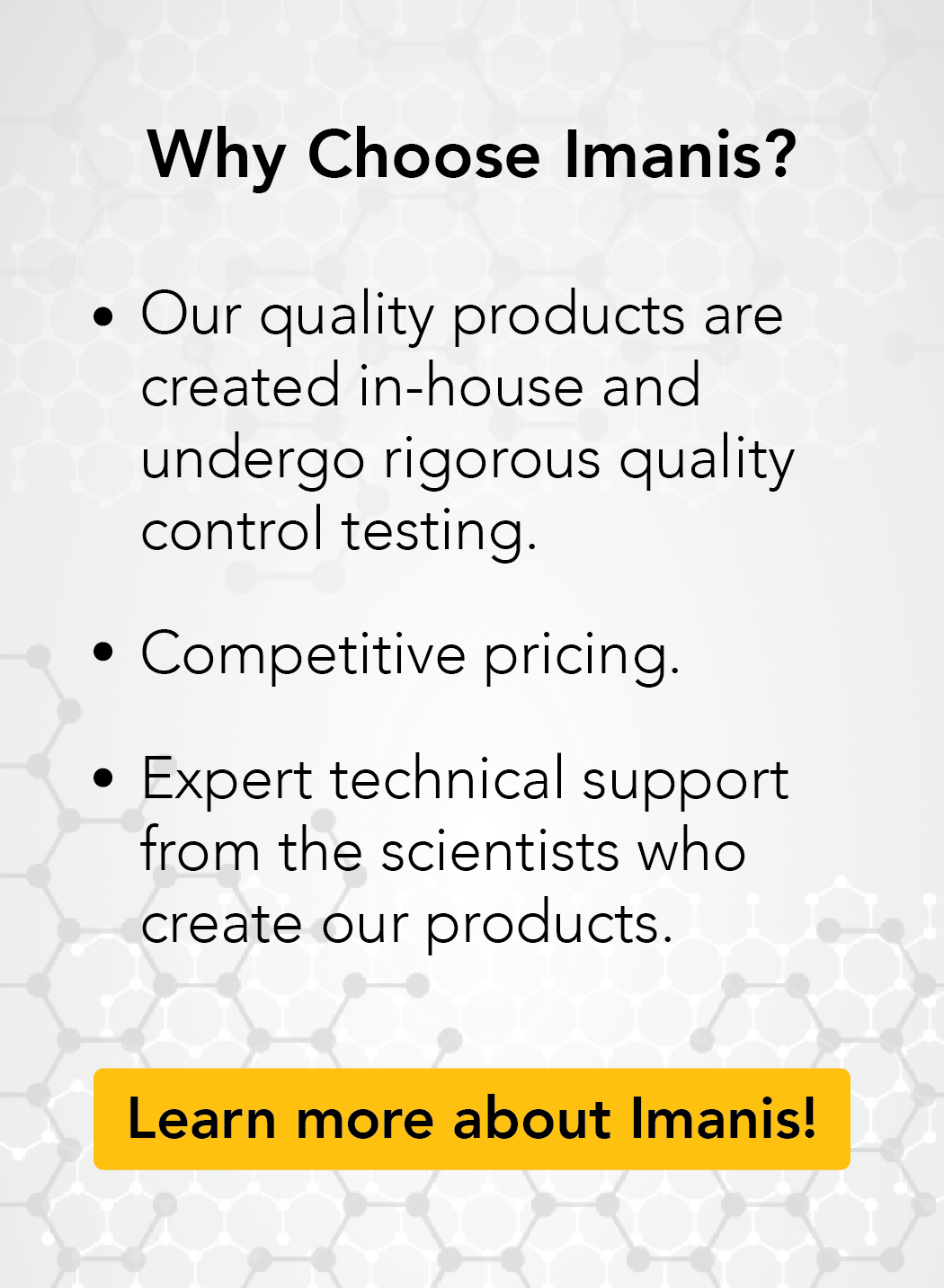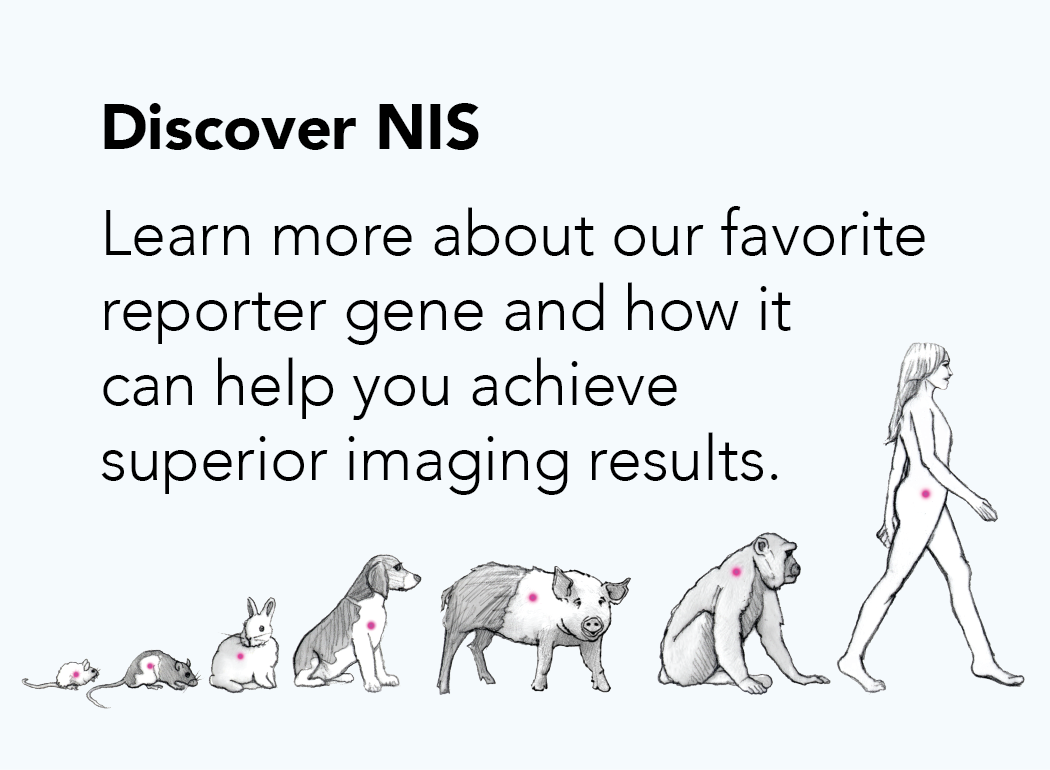Radiotracers for NIS imaging studies
Choosing the best radiotracer for NIS imaging studies
Written March 3, 2017 by Imanis Life Sciences, Rochester MN
There are a lot of reasons to love the nuclear reporter NIS: it is non-immunogenic, gives beautiful high resolution 3D images, works for deep tissue and large animal imaging, is fully quantitative, and is translatable to the clinic. It’s an impressive list; maybe impressive enough that you want to try NIS imaging. But now what do you do? How do you get started?
Well, NIS concentrates certain radiotracers in cells, which can be imaged by PET or SPECT imaging. So first you need to decide what radiotracer and modality to use. We know this can seem intimidating, especially if you’ve never done nuclear imaging before. So let’s review the most commonly used tracers and give a little more information about each to help you make the best decision for your study.
Common PET radiotracers for NIS:
18F-BF4 (tetrafluoroborate) is the prototype radiotracer. It’s relatively easy to synthesize, has high yield emission, minimal background signal, and a low absorbed radiation dose. All of these qualities make 18F-BF4 the most widely used radiotracer. However, it ranks squarely in the middle for NIS affinity, meaning that you will need more of the tracer to get a good signal. And because of its short half-life, 18F-BF4 must be synthesized and used immediately for imaging, which can make scheduling your study more difficult.
124I has a relatively long half-life for a PET tracer, which makes it a convenient choice; you can purchase 124I in advance and then you get a whole day to complete your imaging. However, it has lower yield emission, a higher absorbed radiation dose, and lower sensitivity when compared to 18F-BF4.
A recent paper by Khosnevisan et al. in The Journal of Nuclear Medicine suggested that a new fluorine radiotracer is on the horizon for PET imaging. In their study, Khoshnevisan et al. demonstrated that 18F-SO3F has a higher affinity for NIS than the existing radiotracers and minimal background signal in vitro and in vivo. We are looking forward to seeing more of this substrate in action.
Common SPECT radiotracers for NIS:
99mTc-pertechnetate is the most commonly used radiotracer for SPECT imaging of NIS. It’s clinically approved, relatively affordable, readily available, and has minimal background signal in a variety of tissues. And compared to the other SPECT radiotracers, it has the highest affinity for NIS. 99mTc-pertechnetate also has a short half-life that facilitates rapid data collection and limits radiation exposure, which is important for clinical applications.
123I is widely used for diagnosing and monitoring thyroid diseases in the clinic. However, 123I is a less popular choice for imaging studies because it has a lower affinity for NIS than 99mTc, is relatively expensive, and is not widely available.
125I has a relatively long half-life (60 days). This means that like 124I, you can purchase 125I in advance and have more time to acquire images on the day of imaging. Like 123I, 125I is clinically translatable, and is in fact a core component of several clinically-approved radiopharmaceuticals. However, 125I has a lower affinity for NIS than 99mTc. It also has a lower energy, which leads to lower tissue penetration, so it’s not suited for imaging anything bigger than mice.
Radiotracers for NIS imaging

Choosing a Modality
So PET versus SPECT, how do you choose? Both PET and SPECT are useful for quantitatively detecting deep tissue signal. Both are directly translatable to the clinic. And both are highly sensitive as compared to other imaging modalities. In general, PET sensitivity is superior to SPECT. However, PET radiotracers have shorter half-lives and must be injected quickly after synthesis. Because of this, in-house synthesis of PET radiotracers is usually necessary, which adds to the overall cost and complexity of PET imaging. While SPECT imaging is traditionally more cost-effective and convenient, it tends to be about 10 times less sensitive than PET imaging.
But when choosing a modality, one of the most important factors is probably what you have available at your organization. Imaging equipment is expensive. New models are often superior to old models – so, for example, a new SPECT machine may actually offer better resolution than an old PET one. Plus, personnel must be certified to work with CT (x-rays) and be trained to operate the equipment. Because of these practical considerations, it’s important to use what is already available to you.
So with these considerations in mind, it’s time for you to start NIS imaging. After all, with the kind of information you can get from a NIS study, it’s certainly worth giving it a try.

